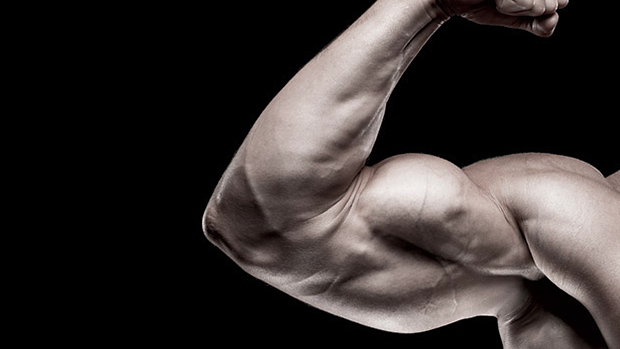Curing TTS – Tiny Triceps Syndrome
Having a tough time building your triceps? Well, here's a question for you: Are you lifting more weight, for more reps, than you were six months ago?
To truly maximize a muscle or muscle group's development there are some things you've got to do to make it respectable. Here they are:
If you're not forcing your body to adapt to a greater amount of stress, then it'll yawn and go "meh, this ain't shit." I know the general consensus among lifters is that volume drives hypertrophy, but doing a bunch of half-assed junk volume just to meet a requirement based on a study doesn't mean shit to your body.
Sure, volume has its place. But striving to do more reps with more weight is what's going to get you to grow. That means you're going to put a high degree of effort into the big movements that tax a significant amount of musculature.
When you look at the strongest bodybuilders, natural or enhanced, more times than not they're the guys pushing the biggest weights for reps. I've yet to see a guy that could close-grip bench press 405 for reps that had small triceps. That should tell you something.
So the first step is finding exercises with a high degree of potential for progressive overload, that you can do pain-free, through a full range of motion, on a consistent basis. A close grip or reverse-grip bench press or dips will have a much higher ceiling for loading than something like pushdowns or kickbacks.
Make those the foundation you're going to build your training around. If you go from close grip or reverse-grip bench pressing 225 x 8 to 275 x 8 in the next six months, your triceps WILL get bigger.
Mind-muscle connection used to be something bodybuilders talked about often, and to some degree it was dismissed as bro-science.
But now we know the meatheads had it right all along, and there's been quite a few studies which validated that feeling the muscle work actually matters. Simply thinking about the muscle you're trying to build can increase the activation of that muscle during movement execution.
It's also been shown that loading plays a part too. What I call the "break-over point" is the point at which the load becomes too heavy for you to establish a strong mind-muscle connection. When that happens, the lift becomes more about moving the weight through space. You lose the increased activation in the target muscle as other muscle groups get more involved to move the weight.
From an intensity loading perspective, something in the range of 60-80% has been shown to be the most effective for maintaining a strong mind-muscle connection. That range also tends to be ideal for muscle growth (8-15 reps) all depending on the lifter and the exercise.
If you're having trouble establishing a mind-muscle connection, begin the workout with something that puts the muscle into a shortened position, and work isometrics (holding the contraction) to help with that. Try a pushdown variation. My favorite for this is the reverse-grip pushdown.
Make a concerted effort to roll your knuckles back towards your body and hold that for a 2-3 count for 3-4 sets.
It's probably a good idea to hit each muscle twice a week for better gene expression and to keep the hormonal production involved in hypertrophy elevated. More growth occurs when muscles are trained twice a week compared to once a week. But three times a week appears to have some diminishing returns compared to twice a week.
Also, don't forget that triceps are involved in all pressing variations. So if you're going to bench press, incline press, overhead press, etc. all in the same week then the tension used for those will get distributed to the triceps as well.
When you're prioritizing a muscle group, reduce volume or effort in the areas not being prioritized. Maintain them. After all, you've only got so much energy to give to a week, so make sure each workout is set up so the energy is spent on the main goal.
Train the lagging muscle early in the workout and also in the week.
Generally, muscles hit early in the workout will get slightly better growth than the ones trained later in the workout. So, train your close-grip work, reverse-grip work, or dips early in the week and first thing in those workouts to give them more of a priority.
The chest and shoulders are still getting a great deal of work when you're doing close grips, reverse grips, and dips. You don't need to start freaking out over losing "gains" in those areas while you prioritize the triceps. You're just not giving them EXTRA attention right now while the triceps are the priority.
Getting stronger on some basic compound movements should be the foundation, but don't leave out higher-rep work that'll induce muscle growth by way of increased metabolites. And you'll need to take some sets to failure to really tap into that modality.
Also, stressing the muscle at different lengths for complete development is a really good idea. While it's impossible to isolate a particular area of a muscle from the rest of it, you can stress different sections of the muscle more than others by movement selection and execution.
The long head of the triceps will bear the brunt of the work in movements where the triceps are put into a full lengthened position – where there's significant shoulder flexion, like with overhead extensions, and PJR pullovers.
The long head of the triceps crosses over the shoulder joint, but the medial and short heads do not, making them slightly more difficult to isolate. So select movements that remove a bit of tension from the long head, and pick ones that shift it more towards the short and medial heads. Pushdowns and dips actually do a great job of that.
Some supersets and giant sets work well for inducing metabolic stress. I have three go-to's for metabolic stress, which stress the muscle at different lengths:
- Do tricep 30's: This is a skull crusher variation where I lower the bar to my nose for 10 reps, then to my forehead for 10 reps, then behind the head for 10 reps.
- Try this giant set: 12 reps of pushdowns, 12 reps of overhead extensions, and 12 reps of bench dips. Do them all back to back, and repeat.
- Or try this giant set: 12 cross-body cable extensions, 12 dips, 12 seated dumbbell French presses. Do them all back to back, and repeat.
Remember, you want to stress the muscle with enough effort and loading so that it's forced to grow, then allow for enough recovery to take place so that growth can happen.
- Am I training hard with enough effort?
- Am I getting stronger in the moderate to higher growth rep ranges (8-15)?
- Am I getting a strong mind-muscle connection with the load I'm using, movement selection, and execution?
- Am I training the muscle often enough so that it's responding to the stress and recovery that induces growth?
- Am I creating metabolic stress as an addition to progressive overload to spur growth?
You don't have to nail all of these points to bring up a lagging muscle group, but doing so will speed up the process. And when you write out your plan so that all of these factors are covered, it actually won't look as complicated as you think.
Here's a sample of how you might hit triceps twice a week. It doesn't really matter which days you choose as long as they're separated reasonably well in the week.
Day 1
| Exercise | Sets | Reps | |
|---|---|---|---|
| A | Reverse-Grip Pushdown: Activation | 3 | 12 |
| Turn the knuckles down and back. Use a 3-second hold at the bottom. | |||
| B | Close-Grip Bench Press: Progressive Overload | 2-3 | 8-12 |
| Start with a weight you can do for 8 reps. When you can do 12 reps with that weight, increase the loading so that you're back to 8 reps. | |||
| C | Cross-Body Cable Extension, Dip, Seated Dumbbell French Press: Giant Set | 3 | 12/each |
Day 2
| Exercise | Sets | Reps | |
|---|---|---|---|
| A | Reverse-Grip Pushdown: Activation | 3 | 12 |
| Turn the knuckles down and back. Use a 3-second hold at the bottom. | |||
| B | Reverse-Grip Bench Press: Progressive Overload | 2-3 | 8-12 |
| Start with a weight you can do for 8 reps. When you can do 12 reps with that weight, increase the weight so that you're back to 8 reps. | |||
| C | Tricep 30's (Skull Crusher): Metabolic Stress | 2 | 30 |
| Lower the bar to your nose for 10 reps, then forehead for 10 reps, then behind the head for 10 reps. That's one set. | |||





